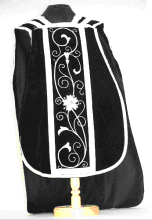
There is no better example of the many different cultural institutions Lethbridge has than its churches. In Lethbridge today there are about 80 churches and nearly 45 different denominations. The Roman Catholic Church, Mormons, United, and Anglican are the largest of these denominations, but unique to Lethbridge are the many other groups present. Reformed, Mennonite, Jehovah's Witness, Pentecostal, and Baptist are all present, in addition to Chinese Alliance, Buddhist, Jewish, and Islamic. These churches are representative of a portion of Lethbridge's culture and some of them have been in the city since its beginnings.

P19900013003-GA This is a chasuble, it is worn by a catholic priest on Good Friday.These types of robes have since been replaced by more subtle styles, this robe dates from around 1920.
The North West Coal and Navigation Company (N.W.C.&N.Co.) knew early on that churches were needed when building a new community, so, between 1886 and 1888 the company offered free land to any churches that would build in Lethbridge. The first church to take one of the lots was the Presbyterian church. Since most of the first miners to come west with the N.W.C.&N.Co. were Scottish and Presbyterian, this was the logical choice. Knox Presbyterian (now United) Church was in use by March 1, 1886 and on July 2 of that year the church's first minister arrived, Rev. Charles McKillop who served until 1904. McKillop, along with Lethbridge druggist and fellow Presbyterian J.D. Higinbotham, supplied the church with religious zeal and an activist tradition. Higinbotham started the first Lethbridge Sunday school and McKillop's sermons were printed in Lethbridge's newspapers. The church operated at many different locations until 1935 when the Presbyterian and Methodist churches were brought together to form the United church. The United church has honoured its first Lethbridge minister by naming one of its churches the Mckillop United Church.

P19693809000 A Chair used in St. Patrick's Roman Catholic Church in 1887.
Another church to take advantage of the N.W.C.&N.Co.'s offer was the Roman Catholic Church. The Catholic church coming to Lethbridge was largely due to the efforts of Father Van Tighem. Born in Flanders in 1851, Van Tighem was trained and worked as a cabinet maker until he came to the Oblate mission in St. Albert, Alberta. While in St. Albert, Van Tighem underwent training for the priesthood and was ordained by Bishop Vital Grandin in 1883. Soon, the young priest was sent on a mission to the Fort Macleod and Pincher Creek areas, while there he was called to offer a mass in Coalbanks to Michael Sheran, the Irish-Catholic brother of Nicholas Sheran. This mass, on May 17, 1884, was the first in Lethbridge's history. Van Tighem returned to Lethbridge the following year to administer the last rites at Sheran's death, at this time he made plans to assemble a Lethbridge congregation and a church. In 1886, Van Tighem began delivering mass in places such as, the Royal Hotel and Alphonse's Hall for as many as 60 people. The building of Lethbridge's first Catholic Church went very well, and in August 1887 Father Lacombe blessed it and appointed Father Van Tighem as resident priest. The church became the first consecrated North American parish west of Manitoba. Van Tighem gained a large following with the European miners, most of whom were Catholic. Having successfully established the church in Lethbridge, Van Tighem moved to Taber in 1909 where he spent his remaining years establishing the church there. Van Tighem died on March 10, 1917 and is remembered today by the westside school which bears his name.

St. Michael's Hospital Chapel, The museum has selected religious objects from the chapel of the St. Michael's hospital before it was demolished in August, 1996. They signify St. Michael's Roman Catholic foundation.
With the roots established by men such as McKillop and Van Tighem, other religious organizations soon followed. The Baptists and Anglicans were the next to establish themselves in Lethbridge followed later by Reformed, Lutherans, and others. Many of the later groups were associated with ethnic as much as religious ties, among these were the Mennonites, Buddhist, and Chinese Christian churches. Not least among the religious groups which settled in southern Alberta were the Mormons, whose story is told within the chapter "people of Lethbridge".
Previous Page | Exhibit Contents | Home | Navigation Information | Glossary | Curriculum Guide | Next Page
Copyright © 1996 Sir Alexander Galt Museum. All rights reserved.